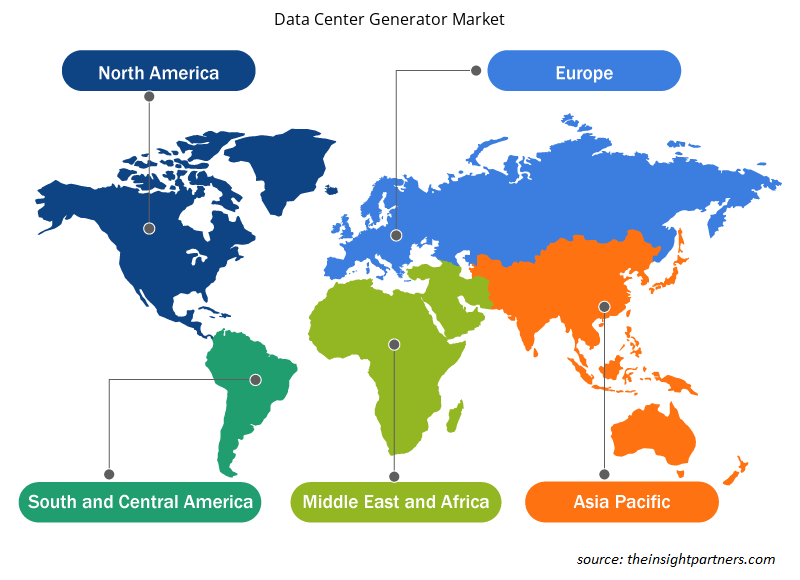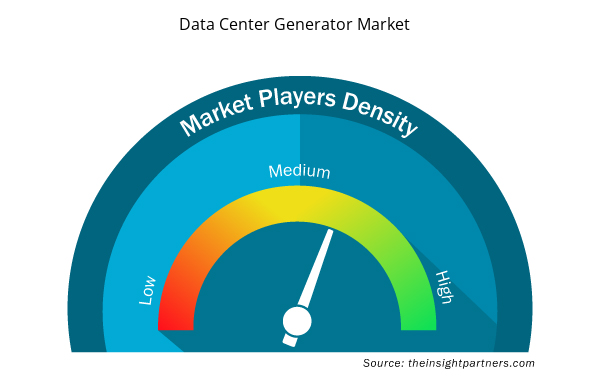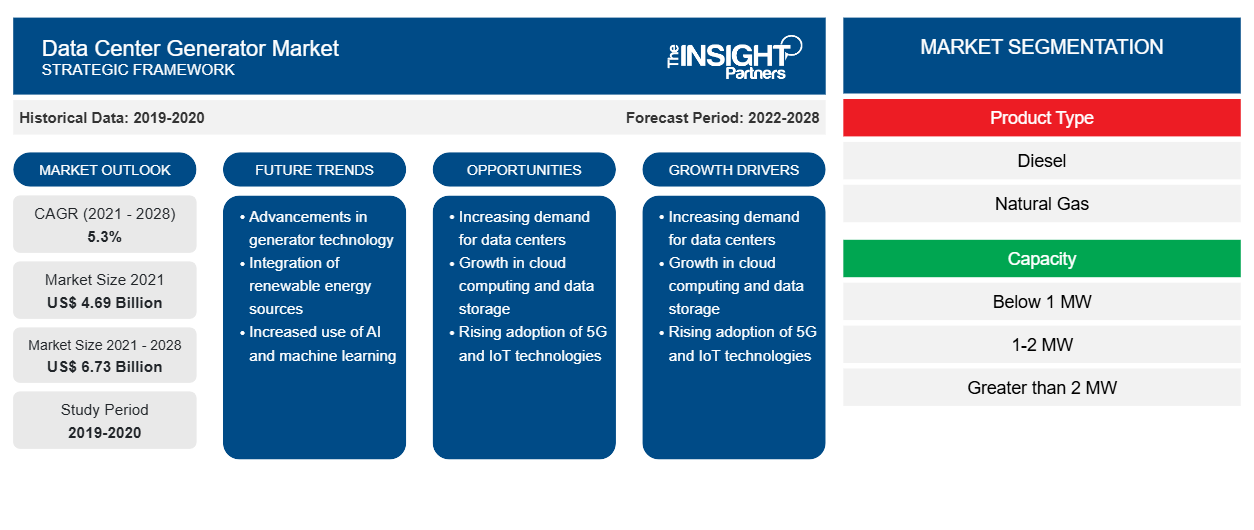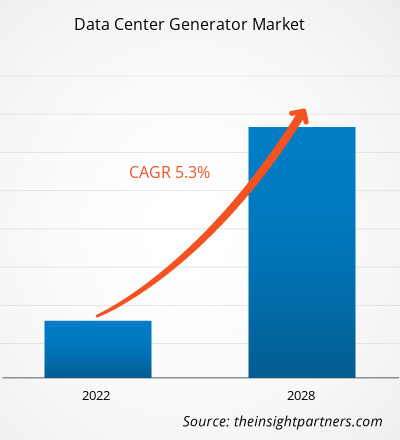[Rapporto di ricerca] Il mercato dei generatori per data center è stato valutato a 4.693,00 milioni di dollari nel 2021 e si prevede che raggiungerà i 6.729,53 milioni di dollari entro il 2028; si stima che registrerà un CAGR del 5,3% dal 2021 al 2028.
I generatori fungono da riserva di alimentazione di riserva per i data center durante un'interruzione di corrente. Un'interruzione di corrente totale in un data center potrebbe richiedere un riavvio del sistema, con conseguenti tempi di inattività del sistema, difficoltà di avvio e perdita di dati. Pertanto, i data center sono sempre supportati da un'alimentazione di riserva fornita dai generatori per evitare tali anomalie e guasti. Tali vantaggi stanno guidando la crescita del mercato dei generatori per data center .
Questi generatori non necessitano di un alimentatore esistente per funzionare, il che è un elemento trainante significativo per il mercato. Inoltre, importanti produttori realizzano generatori con capacità personalizzata in risposta alle mutevoli richieste dei clienti. Tali sistemi possono essere scalati in base ai requisiti di potenza del data center. Questa adattabilità probabilmente aumenterà la domanda di generatori per data center, stimolando così la crescita del mercato. Diversi fornitori di servizi cloud hanno aumentato la loro produzione a causa dell'aumento della domanda di data center edge in tutto il mondo. Google, ad esempio, ha speso 3,3 miliardi di dollari nel 2019 per espandere la sua presenza nei data center in Europa. Inoltre, è probabile che il mercato trarrà vantaggio dall'aumento dello sviluppo di strutture su larga scala e dall'aumento dell'implementazione di gruppi di continuità rotanti diesel (DRUP).
Personalizza questo report in base alle tue esigenze
Riceverai la personalizzazione gratuita di qualsiasi report, comprese parti di questo report, o analisi a livello nazionale, pacchetto dati Excel, oltre a usufruire di grandi offerte e sconti per start-up e università
- Scopri le principali tendenze di mercato in questo rapporto.Questo campione GRATUITO includerà analisi di dati che spaziano dalle tendenze di mercato alle stime e alle previsioni.
Approfondimenti sul mercato dei generatori di data center
Aumento del numero di data center
Ci sono già circa sette miliardi di dispositivi connessi a Internet in questa era di dati, e questa cifra è in crescita. Molti di loro producono enormi quantità di dati, che devono essere registrati, instradati, archiviati, valutati e recuperati. I produttori si affidano ai big data e all'analisi dei dati per migliorare l'efficienza, la produttività, la sicurezza e l'economicità delle loro operazioni man mano che Internet of Things (IoT) e Industry 4.0 prendono piede. D'altro canto, la gestione dei dati interna sta diventando sempre più complicata, dispendiosa in termini di tempo e denaro. Per risparmiare sui costi energetici e infrastrutturali, persino grandi aziende come Cisco prendono in considerazione la chiusura di parti dei propri data center interni.
L'aumento della penetrazione dei dispositivi connessi e il facile accesso a Internet, insieme alla riduzione dei costi dei servizi Internet, stanno spingendo la domanda di archiviazione dati a livello globale. La necessità di archiviazione dati sta aumentando anche a causa della crescente domanda di analisi di big data e servizi basati su cloud, come contenuti online che comprendono film, app, video e social media. Pertanto, le aziende basate su cloud distribuiscono spazio IT nei loro data center. Diversi settori stanno esplorando le offerte cloud e scoprendo i vantaggi dei servizi di data center per supportare le loro esigenze relative al cloud. Questi sviluppi stanno influenzando direttamente l'aumento dell'uso dell'Internet of Things (IoT), determinando così la costruzione di un gran numero di data center in tutto il mondo. Ad esempio, Colt ha annunciato lo sviluppo dei suoi data center hyperscale in Europa e Asia-Pacifico, in seguito alla vendita di 12 centri di colocation edge in tutta Europa. La società ha acquistato dieci nuovi appezzamenti di terreno a Londra, Francoforte, Parigi e in località non divulgate in Giappone che le consentiranno di creare circa 100 MW di potenza IT. Pertanto, il crescente numero di data center aumenta la necessità di generatori per data center di disporre di un'alimentazione elettrica sufficiente, fattore che sta determinando la crescita del mercato dei generatori per data center.
Approfondimenti di mercato basati sul tipo di prodotto
Negli ultimi anni, i generatori per data center hanno registrato un aumento della domanda in tutto il mondo. Le aziende forniscono tre tipi di generatori per data center: diesel, gas naturale e bi-fuel. A gennaio 2022, Cummins Power Generation ha annunciato di essere stata premiata per le sue soluzioni di alimentazione dall'industria dei data center cinese. L'azienda produce generatori diesel per data center. A gennaio 2021, TRG Datacenters ha annunciato l'aggiornamento del suo data center in Texas. L'azienda sta pianificando di installare un'opzione bi-fuel per il backup dell'alimentazione
Approfondimenti di mercato basati sulla capacità
In termini di capacità, la dimensione del mercato dei generatori dei data center è segmentata in inferiore a 1 MW, 1-2 MW e superiore a 2 MW. Inferiore a 1 MW è la capacità più importante nei generatori dei data center. Le strutture con una capacità superiore a 10 MW stanno adottando generatori superiori a 2 MW. I generatori con una capacità di potenza inferiore a 1 MW sono solitamente adottati in implementazioni di data center modulari. Si prevede che l'adozione di generatori con una capacità di potenza inferiore a 1 MW aumenterà l'implementazione dei data center. Vengono adottati da operatori di data center su piccola scala nelle economie in via di sviluppo in quanto sono meno costosi. L'aumento della produzione di strutture su larga scala nelle economie emergenti ridurrebbe la dipendenza dai generatori con bassa capacità nei prossimi anni.
Gli attori del mercato dei generatori di data center adottano strategie quali fusioni, acquisizioni e iniziative di mercato per mantenere le loro posizioni nel mercato. Di seguito sono elencati alcuni sviluppi da parte degli attori chiave del mercato dei generatori di data center:
- ABB LTD ha introdotto una nuova tecnologia di generatore ad albero. Questo nuovo generatore offre flessibilità e facilità di installazione a molte imbarcazioni, tra cui portarinfuse e portacontainer. Il generatore ad albero a magnete permanente AMZ 1400 è ottimizzato per il controllo del convertitore e consente una migliore efficienza rispetto all'induzione.
- Caterpillar lancia un progetto dimostrativo che utilizza la tecnologia delle celle a combustibile a idrogeno per l'alimentazione di backup presso il Microsoft Data Center. Questo progetto consente a Caterpillar di collaborare con i leader del settore per compiere un grande passo avanti verso soluzioni di alimentazione commercialmente valide che supportano anche i clienti nel rendere le loro operazioni più sostenibili.
Approfondimenti regionali sul mercato dei generatori di data center
Le tendenze regionali e i fattori che influenzano il mercato dei generatori di data center durante il periodo di previsione sono stati ampiamente spiegati dagli analisti di Insight Partners. Questa sezione discute anche i segmenti e la geografia del mercato dei generatori di data center in Nord America, Europa, Asia Pacifico, Medio Oriente e Africa e America meridionale e centrale.

- Ottieni i dati specifici regionali per il mercato dei generatori di data center
Ambito del rapporto di mercato del generatore di data center
| Attributo del report | Dettagli |
|---|---|
| Dimensioni del mercato nel 2021 | 4,69 miliardi di dollari USA |
| Dimensioni del mercato entro il 2028 | 6,73 miliardi di dollari USA |
| CAGR globale (2021 - 2028) | 5,3% |
| Dati storici | 2019-2020 |
| Periodo di previsione | 2022-2028 |
| Segmenti coperti | Per tipo di prodotto
|
| Regioni e Paesi coperti | America del Nord
|
| Leader di mercato e profili aziendali chiave |
|
Densità dei player del mercato dei generatori di data center: comprendere il suo impatto sulle dinamiche aziendali
Il mercato dei generatori di data center sta crescendo rapidamente, spinto dalla crescente domanda degli utenti finali dovuta a fattori quali l'evoluzione delle preferenze dei consumatori, i progressi tecnologici e una maggiore consapevolezza dei vantaggi del prodotto. Con l'aumento della domanda, le aziende stanno ampliando le loro offerte, innovando per soddisfare le esigenze dei consumatori e capitalizzando sulle tendenze emergenti, il che alimenta ulteriormente la crescita del mercato.
La densità degli operatori di mercato si riferisce alla distribuzione di aziende o società che operano in un particolare mercato o settore. Indica quanti concorrenti (operatori di mercato) sono presenti in un dato spazio di mercato in relazione alle sue dimensioni o al valore di mercato totale.
Le principali aziende che operano nel mercato dei generatori per data center sono:
- ABB
- Atlas Copco Italia
- Bruco
- Società per azioni Cummins Inc.
- DEUTZ AG
Disclaimer : le aziende elencate sopra non sono classificate secondo un ordine particolare.

- Ottieni la panoramica dei principali attori del mercato dei generatori di data center
Il mercato globale dei generatori per data center è segmentato in base al tipo di prodotto, alla capacità e al livello. In base al tipo di prodotto, il mercato dei generatori per data center è segmentato in diesel, gas naturale e altri. In termini di capacità, il mercato dei generatori per data center è segmentato in meno di 1 MW, 1-2 MW e più di 2 MW. Inoltre, in base al livello, il mercato dei generatori per data center è segmentato in livello 1 e 2, livello 3 e livello 4.
ABB; Atlas Copco AB; Caterpillar; Cummins Inc.; DEUTZ AG; Generac Power Systems, Inc.; HITEC Power Protection; Kirloskar; Kohler Co.; e MITSUBISHI MOTORS CORPORATION sono i principali attori del mercato dei generatori per data center presi in considerazione per lo studio di ricerca. Inoltre, diversi altri importanti attori del mercato dei generatori per data center sono stati studiati e analizzati in questo rapporto di ricerca per ottenere una visione olistica delle dimensioni del mercato globale dei generatori per data center e del suo ecosistema.
- Analisi storica (2 anni), anno base, previsione (7 anni) con CAGR
- Analisi PEST e SWOT
- Valore/volume delle dimensioni del mercato - Globale, regionale, nazionale
- Industria e panorama competitivo
- Set di dati Excel


- Hydrogen Storage Alloys Market
- Energy Recovery Ventilator Market
- Equipment Rental Software Market
- Analog-to-Digital Converter Market
- Fishing Equipment Market
- Small Internal Combustion Engine Market
- Aircraft Landing Gear Market
- Vaginal Specula Market
- Digital Language Learning Market
- USB Device Market

Report Coverage
Revenue forecast, Company Analysis, Industry landscape, Growth factors, and Trends

Segment Covered
This text is related
to segments covered.

Regional Scope
North America, Europe, Asia Pacific, Middle East & Africa, South & Central America

Country Scope
This text is related
to country scope.
Domande frequenti
The rising inclination towards renewables are environmental sustainability and energy savings is positively impacting the data center generator market. When rising and unpredictable energy costs and levies linked with pending carbon emission regulations are considered, it is easy to see why operators are becoming more interested in renewables' role in lowering and stabilizing energy costs. Google's hyper-scale data centers have been pioneers in renewable energy programs, researching their inherent financial, environmental, and social value. Google chooses locations for its data centers based on various considerations, including the availability of reliable service and the opportunity for renewable energy. Thus, these initiatives are further expected to contribute to the growth of the data center generator market over the forecast period.
The diesel segment led the data center generator market with a market share of 69.7% in 2020. It is expected to account for 68.7% of the total market in 2028.
Most data centers maintain enough fuel on hand to run the generator for 24-48 hours. To preserve sensitive data, data centers require dependable backup power. Thus, the global data center generator market is primarily driven by the increase in number of data centers and in backup power supply requirements in data centers.
North America dominated the data center generator market in 2020 with a share of 37.25%; it would continue to dominate the market during the forecast period and account for 31.67% share by 2028. Europe is the second-largest contributor to the global data center generator market, followed by Asia Pacific.
ABB; Atlas Copco AB; Caterpillar; Cummins Inc.; DEUTZ AG; Generac Power Systems, Inc.; HITEC Power Protection; Kirloskar; Kohler Co.; and MITSUBISHI MOTORS CORPORATION.
The less than 1MW segment led the data center generator market with a market share of 44.4% in 2020. It is expected to account for 46.1% of the total market in 2028.
Trends and growth analysis reports related to Energy and Power : READ MORE..
The List of Companies - Data Center Generator Market
- ABB
- Atlas Copco AB
- Caterpillar
- Cummins Inc.
- DEUTZ AG
- Generac Power Systems, Inc.
- HITEC Power Protection
- Kirloskar
- Kohler Co.
- MITSUBISHI MOTORS CORPORATION
The Insight Partners performs research in 4 major stages: Data Collection & Secondary Research, Primary Research, Data Analysis and Data Triangulation & Final Review.
- Data Collection and Secondary Research:
As a market research and consulting firm operating from a decade, we have published and advised several client across the globe. First step for any study will start with an assessment of currently available data and insights from existing reports. Further, historical and current market information is collected from Investor Presentations, Annual Reports, SEC Filings, etc., and other information related to company’s performance and market positioning are gathered from Paid Databases (Factiva, Hoovers, and Reuters) and various other publications available in public domain.
Several associations trade associates, technical forums, institutes, societies and organization are accessed to gain technical as well as market related insights through their publications such as research papers, blogs and press releases related to the studies are referred to get cues about the market. Further, white papers, journals, magazines, and other news articles published in last 3 years are scrutinized and analyzed to understand the current market trends.
- Primary Research:
The primarily interview analysis comprise of data obtained from industry participants interview and answers to survey questions gathered by in-house primary team.
For primary research, interviews are conducted with industry experts/CEOs/Marketing Managers/VPs/Subject Matter Experts from both demand and supply side to get a 360-degree view of the market. The primary team conducts several interviews based on the complexity of the markets to understand the various market trends and dynamics which makes research more credible and precise.
A typical research interview fulfils the following functions:
- Provides first-hand information on the market size, market trends, growth trends, competitive landscape, and outlook
- Validates and strengthens in-house secondary research findings
- Develops the analysis team’s expertise and market understanding
Primary research involves email interactions and telephone interviews for each market, category, segment, and sub-segment across geographies. The participants who typically take part in such a process include, but are not limited to:
- Industry participants: VPs, business development managers, market intelligence managers and national sales managers
- Outside experts: Valuation experts, research analysts and key opinion leaders specializing in the electronics and semiconductor industry.
Below is the breakup of our primary respondents by company, designation, and region:

Once we receive the confirmation from primary research sources or primary respondents, we finalize the base year market estimation and forecast the data as per the macroeconomic and microeconomic factors assessed during data collection.
- Data Analysis:
Once data is validated through both secondary as well as primary respondents, we finalize the market estimations by hypothesis formulation and factor analysis at regional and country level.
- Macro-Economic Factor Analysis:
We analyse macroeconomic indicators such the gross domestic product (GDP), increase in the demand for goods and services across industries, technological advancement, regional economic growth, governmental policies, the influence of COVID-19, PEST analysis, and other aspects. This analysis aids in setting benchmarks for various nations/regions and approximating market splits. Additionally, the general trend of the aforementioned components aid in determining the market's development possibilities.
- Country Level Data:
Various factors that are especially aligned to the country are taken into account to determine the market size for a certain area and country, including the presence of vendors, such as headquarters and offices, the country's GDP, demand patterns, and industry growth. To comprehend the market dynamics for the nation, a number of growth variables, inhibitors, application areas, and current market trends are researched. The aforementioned elements aid in determining the country's overall market's growth potential.
- Company Profile:
The “Table of Contents” is formulated by listing and analyzing more than 25 - 30 companies operating in the market ecosystem across geographies. However, we profile only 10 companies as a standard practice in our syndicate reports. These 10 companies comprise leading, emerging, and regional players. Nonetheless, our analysis is not restricted to the 10 listed companies, we also analyze other companies present in the market to develop a holistic view and understand the prevailing trends. The “Company Profiles” section in the report covers key facts, business description, products & services, financial information, SWOT analysis, and key developments. The financial information presented is extracted from the annual reports and official documents of the publicly listed companies. Upon collecting the information for the sections of respective companies, we verify them via various primary sources and then compile the data in respective company profiles. The company level information helps us in deriving the base number as well as in forecasting the market size.
- Developing Base Number:
Aggregation of sales statistics (2020-2022) and macro-economic factor, and other secondary and primary research insights are utilized to arrive at base number and related market shares for 2022. The data gaps are identified in this step and relevant market data is analyzed, collected from paid primary interviews or databases. On finalizing the base year market size, forecasts are developed on the basis of macro-economic, industry and market growth factors and company level analysis.
- Data Triangulation and Final Review:
The market findings and base year market size calculations are validated from supply as well as demand side. Demand side validations are based on macro-economic factor analysis and benchmarks for respective regions and countries. In case of supply side validations, revenues of major companies are estimated (in case not available) based on industry benchmark, approximate number of employees, product portfolio, and primary interviews revenues are gathered. Further revenue from target product/service segment is assessed to avoid overshooting of market statistics. In case of heavy deviations between supply and demand side values, all thes steps are repeated to achieve synchronization.
We follow an iterative model, wherein we share our research findings with Subject Matter Experts (SME’s) and Key Opinion Leaders (KOLs) until consensus view of the market is not formulated – this model negates any drastic deviation in the opinions of experts. Only validated and universally acceptable research findings are quoted in our reports.
We have important check points that we use to validate our research findings – which we call – data triangulation, where we validate the information, we generate from secondary sources with primary interviews and then we re-validate with our internal data bases and Subject matter experts. This comprehensive model enables us to deliver high quality, reliable data in shortest possible time.


 Ottieni un campione gratuito per questo repot
Ottieni un campione gratuito per questo repot